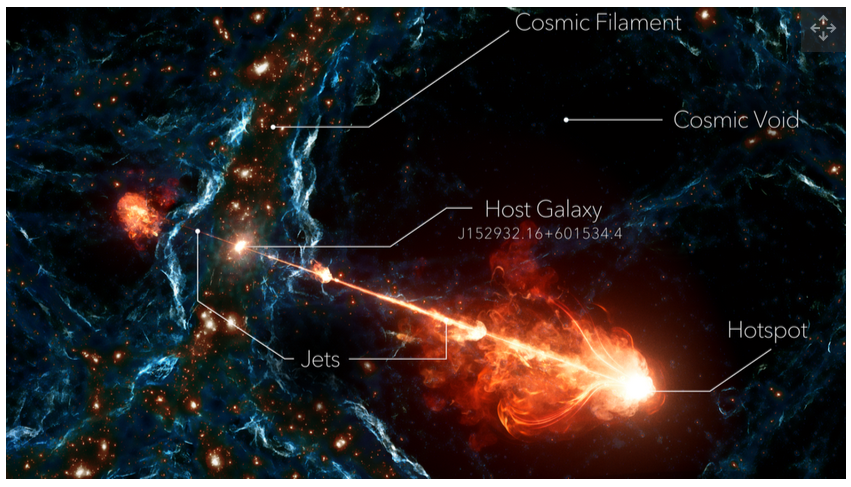Astronomers have found the largest pair of black hole jets ever seen, stretching a staggering 23 million light-years across space. To put that into perspective, these jets are about 240 times the diamter of our Milky Way galaxy (~100 thousand ligth-years), one of the largest structures ever observed in the universe. Named “Porphyrion,” after a giant from Greek mythology, these jets were shot out by a supermassive black hole in a galaxy 7.5 billion light-years away, meaning we’re seeing them as they were when the Universe was about half its current age.

Around 10% of the Active Galactic Nuclei (galaxies that host an active super-massive black hole in their center) have relativistic outflows (aka the jets) at which hot electrons (plasma) move with incredibly high velocities reaching the speed of light. The material that falls into the black hole creates an accretion disc which is highly conducting and it produces a magnetic field as it rotates around the black hole. The changing magnetic field creates strong electric field capable of accelerating charged particles and boost them from the central engine creating two jets vertical to the level of the accretion disc at two opposite directions.
Hence, black hole jets are powerful streams of particles and radiation that shoot out from the poles of a black hole. In this case, the jets are releasing trillions of times more energy than the Sun every second, pushing huge amounts of material into space. What’s remarkable about Porphyrion is that these jets have stayed intact over an incredibly long distance, despite being formed when the universe was much denser than it is today. Scientists had previously thought that black hole jets couldn’t grow beyond about 16 million light-years in length, but Porphyrion, at 23 million light-years, has shattered that assumption. Porphyrion was the greatest of the giants alongside Alcyoneus, who lends his name to the next largest set of black hole jets, which were discovered in 2022 by the same team of scientists.

The structure of Porphyrion consists of two jets, one stretching to the north and the other to the south, with bright spots where the jets hit the surrounding gas and create shock waves. These jets have traveled so far into space that they reach beyond the host galaxy and into the vast emptiness between galaxies. The discovery of such a large system suggests that black hole jets can affect not only their own galaxies but also neighboring galaxies by pushing material and magnetic fields across huge areas.
This discovery could change the way we think about the role of black holes in shaping the Universe. Astronomers have long believed that black hole jets help control how galaxies grow by spreading energy through space, but the sheer size of Porphyrion suggests that these effects can stretch much farther than previously thought. In fact, this discovery hints that jets like these may have had a bigger impact on the formation of galaxies in the early universe than scientists ever imagined.
The discovery of Porphyrion also raises exciting questions about how many more such structures are out there, waiting to be found. More than 10,000 black hole jet systems have been identified, but the existence of Porphyrion suggests that there could be even more massive ones still hidden in the depths of space. As astronomers continue to explore the Universe, we may learn that black holes and their jets have played a much larger role in shaping the cosmos than we ever realized.
The findings are reported in a new paper, ‘Black hole jets on the scale of the cosmic web’, published in the journal Nature.
